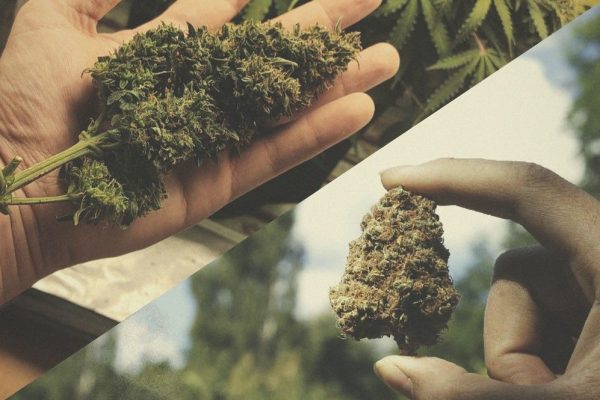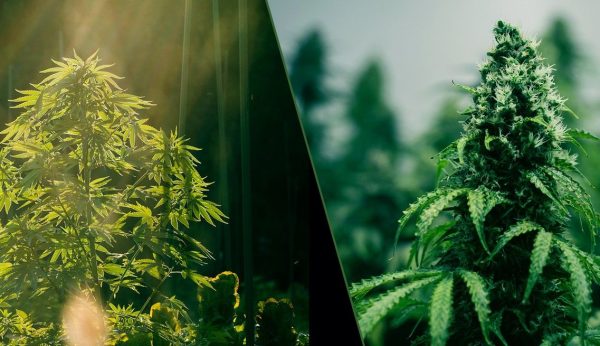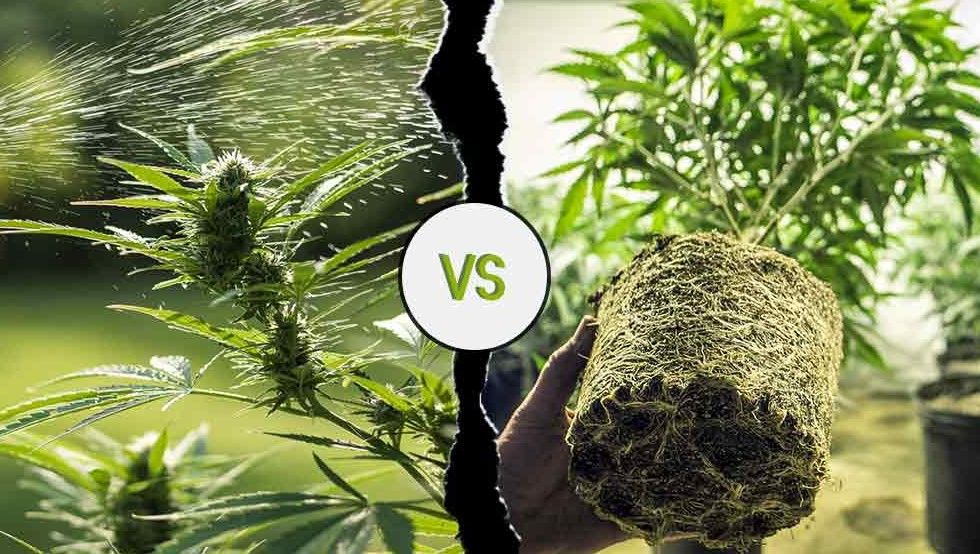This post was created to assist you make sense of the numerous types of cannabis available at dispensaries. This isn’t true for every strain, since each has its own set of characteristics and responds differently to farmers’ treatments. However, these techniques may be used to examine the many minute distinctions between cannabis cultivated outside or inside. Cannabis is a diverse and indeterminable plant; not all distinguishing features are relevant in every scenario because each strain is unique.
We recommend that you try one of indoors strains Alien OG.
Buds may appear great or awful, whether they were nurtured indoors or outside. Buds that are poorly developed inside a home might seem to be outdoor, but well-developed outdoor marijuana can look like indoor. There are some distinct indications that cannabis has been grown indoors vs. outdoors, so sit back and take a look at our picture guide to indoor vs. outdoor marijuana.
To begin, let’s do a baseline calibration to figure out where you are starting from.
Which one of these plants was grown in a greenhouse and which was grown outside?
If you guessed that A was outside and B was inside, you were correct! Let’s look at how to tell if cannabis was produced in a greenhouse or an open field.
Indoor vs. Outdoor Weed: Size
The sizes of the buds are, in many cases, the first indicators to show if they were produced inside or outside. However, it is a widespread misconception that outdoor-grown cannabis gives everything a boost. The buds themselves are larger and chunkier, but examining the stem is one of the most dependable ways to tell the difference. Outdoor grown buds will have a thicker stem than those cultivated indoors. Indoor nuggets will generally be smaller and denser than outdoor’s big, heavy nugs.

Indoor vs. Outdoor Weed: Trichome Density
When attempting to determine if a cannabis plant has been grown indoors or outdoors, the trichome density is a significant visual clue. Indoor buds are smaller, closer to the light source, and under more light control than outdoor buds, therefore they generally contain more trichomes. All that may be observed in an immaculately maintained indoor nug is sparkling crystals with little plant material perceptible. Outdoor plants, on the other hand, have larger nuggets, so the trichomes must work much harder to cover the entire surface of an outdoor bud. Furthermore, because outdoor plants are exposed to the elements, trichome formation may be disrupted. As a result, outside-grown nuggets usually have fewer trichomes than those produced indoors.
Indoor vs. Outdoor Weed: Color
One of the most significant visual distinctions between sun-grown cannabis and indoor-grown cannabis is the color. In general, outdoor cannabis has a darker tone. Outdoor buds will appear greener, possibly leaning toward brown if not cured correctly, while indoor nuggets will be a brighter and more vivid green. If the cultivar has purple blooms, outdoors buds will be a deep, vibrant purple, but indoor nuggets will remain lighter hues of purple (unless the strain’s genetics create dark purple buds in any condition).
The color of the petals’ bottom is also a visual indicator. The stalk at the base of the bud has a light brown hue surrounding it (don’t worry, it’s not mold). The tiny bracts at the tip of the stem are frequently white or pale yellow. Indoor buds, on the other hand, have a bright green (or purple) hue throughout.
Indoor vs. Outdoor Weed: Cannabinoids
There’s a widespread belief that outdoor cannabis is less effective than indoor cannabis. Simply said, this isn’t correct. Sunna Ra Acres’ expert farmers have debunked this misconception once and for all by conducting side-by-side comparisons of two clones taken from the same mother plant over the past several years.
The researchers determined that, when cultivated outside in the sun, a wide range of marijuana plants all create a better total cannabinoid profile. That means higher THC, CBD, THCV, and so on. Their research revealed that exposing a plant to the sun allows it to reach its full potential and improve its therapeutic efficacy.
Indoor vs. Outdoor Weed: Terpenes
In this example, terpenes are comparable to cannabinoids in that exposure to the sun improves their profiles. Sunna Ra Acre’s extensive study has revealed that plants cultivated outdoors have greater terpene levels than those grown inside. The plants themselves have been observed producing previously unknown terpenes in some circumstances. When these two plants are smoked, the difference is very apparent; the outdoor has a superior flavor and fragrance profile. Terpenes, on the other hand, are extremely flammable and will evaporate if not adequately dried and cured.
Indoor producers are more attentive in the final stages of drying and curing since they make less and their product is moved from one indoor location to another, giving them greater control throughout the process. New outdoor gardeners versus experienced outdoor gardeners may overlook the need for careful drying, which could result in a low-terpene profile.
Indoor vs. Outdoor Weed: Trim Job
This is a very debatable point, as many consider it to be entirely subjective. Outdoor growers, on the other hand, have trimmed their completed product less frequently than indoor farmers. This is because outdoor farmers are harvesting 5, 10, or 20 pounds per plant while indoor farmers are collecting only 0.5, 1, or 2 pounds per plant. It would take weeks to trim a lot of cannabis for each plant and a large full-time staff would be needed. Because of this, the ideal product is frequently a looser, greener trim job — especially because outdoor plants are leafier in general. So, while it’s not always correct, you may usually tell if it’s an outdoor or indoor plant based on the trim work.
When you go through all of these features, with some leeway, as you compare the hundreds of buds available for purchase at your local dispensary, you’ll be able to tell an outdoor grown from an indoor grown. If you have access to the same flower plant both indoors and outside, it’s fascinating to smoke them side by side and notice how different their flavor profiles are from one another. Indoor flowers generally have a greater bag appeal than outdoor flowers do – it’s all about what you’re looking for in your daily smoke.
There’s one major elephant in the room that we haven’t addressed yet, and it’s greenhouse-grown cannabis. Greenhouses are indoor production facilities that rely on sunlight for power. It’s a perfect marriage of both indoor and outdoor living since you get the benefits of indoor environments without sacrificing quality. The end product is generally buds with the look of an indoor grow plus enhanced terpene and cannabinoid levels achieved through outdoor growth.

Indoor vs. Outdoor Weed: FAQs
Can You Smoke Brown Weed?
Yes, you can, but the impact won’t be as powerful or delicious. Cannabis is damaged by heat, light, and time. The degradation of THC and other chemicals such as CBG and CBD cause brown marijuana to lose potency and therapeutic value. Furthermore, due to oxidation or evaporation of terpenes, it has lost a lot of its fragrance and taste. Brown marijuana is not poisonous to consume; however, it is not recommended for consumption.
Cannabis is damaged by the sun’s ultraviolet radiation (UV). According to a study done in London in 1976, light was the primary cause of cannabis deterioriation. Cannabis burns or is exposed to too much sunshine throughout growth will acquire a tan color. Cannabidiolic acid (CBDA) is a chemical produced by the plant that gives color and has been shown to convert into cannabidiol after lengthy contact with cannabidiolic acid (CBDA), and THCV will degrade into CBV. If the cannabis has been exposed to direct sunlight, it’s possible that some THC may remain, but the cannabinoids were at least partially changed or decarboxylated out of the plant by the sun.
How Much of a Difference in Quality is Outdoor vs. Indoor Weed?
Both high-quality cannabis plants grown in confinement and those grown outdoors have certain characteristics, yet they differ significantly in quality.
The primary distinction between indoor and outdoor cannabis cultivation is the management of its surroundings. During indoor development, temperature, light, water, humidity, carbon dioxide (CO2) exposure, and care will all be simpler to manage. Some strains may appear to develop a little more wild outside of their controlled environment, but they make equal amounts of THC and terpenes as those grown indoors. Because nature is unpredictable,
The greatest advantage of cannabis gardening outside is energy efficiency. Using all of the sunshine or only part of it to grow marijuana may save home growers and major-scale producers a lot of money on utility bills. Many businesses have installed extra light grows in states where regulations allow them, taking use of daylight and accounting for its variation throughout the year.
Not whether it was grown indoors or outdoors, but rather how well the seeds, the grower’s knowledge, and the attention paid to it determine quality. Because of its ideal growing conditions in the Emerald Triangle region of Humboldt, Mendocino, and Trinity counties, California got its name. Rules may force grows to be hidden from public view and confined to inside in a few legalised cannabis states.

